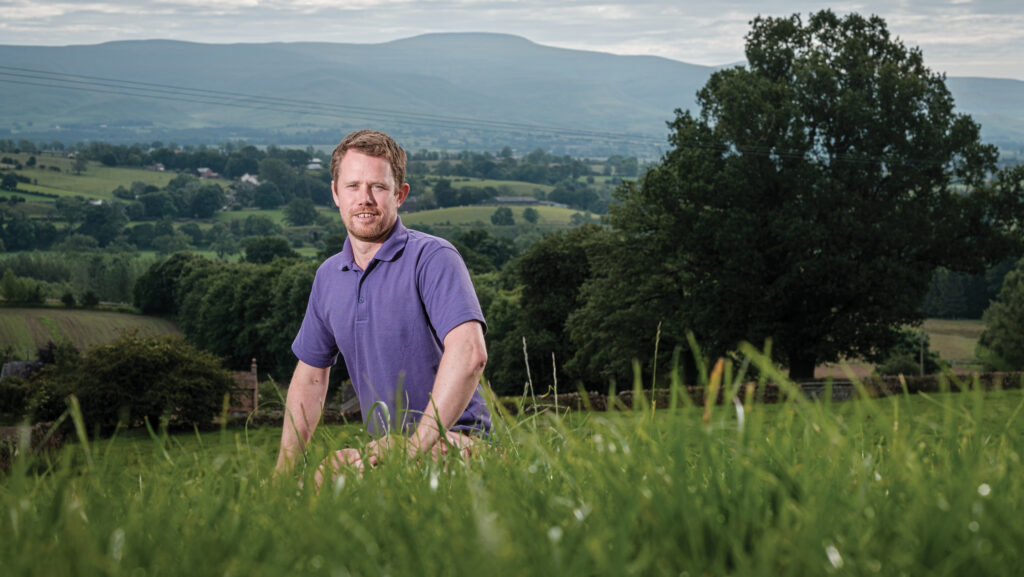How grassland winner is learning new skills for herbal leys
 James Tweedie © Jim Varney
James Tweedie © Jim Varney Having learned how to manage ryegrass to maximise its efficiency, James Tweedie, Farmers Weekly’s Grassland Farmer of the Year, is now in an “experimental” phase finding out how to do the same with herbal leys.
“We are new to herbals and haven’t got a lot of experience yet.
“Given that last year was an unusual weather/grazing season, it’s hard to judge their success so far,” says James, of South Dyke Farm, Penrith, Cumbria.
See also: 7 top tips on establishing herbal leys
Farm facts
South Dyke Farm, Penrith, Cumbria
- 400 spring-calving cows
- Farming 250ha
- Average lactation 4,500 litres
- Friesians average 8.5-9% milk solids
- 60 breeding bulls and surplus heifers sold annually
- Light, stony, free-draining soil
- 900mm rain a year
“We were a fairly textbook spring-calving and grazing herd. Now we are learning about soil and herbs.
“It is definitely going to be different, and we have to be open minded.”
South Dyke is in a rain shadow, with 900mm of annual rainfall.
Together with light soils, this creates a relatively dry farm – although not consistently dry enough to warrant switching to an autumn calving pattern, says James.
However, he thinks climate change is having an influence on ryegrass growth and finds that keeping year-round plant quality is not so easy, because it soon goes to seed when stressed.
Plantain and chicory
Having started to make better use of clover about seven years ago, James became more conscious of soil health.
Herbal leys were the “natural” next step. About 25% of the farm (40-50ha (99-124 acres)) now includes herbs such as plantain and chicory alongside red and white clovers.
The aim, he says, is to help soil structure, plant growth and quality.
“Clover seems like an absolute must: nitrogen fixation is a no-brainer.
“We certainly think we can reduce N [nitrogen] usage to 50% – maybe further,” he says of the farm’s current average 120kg N/ha.
The oldest herbal swards, established four seasons ago, were initially managed no differently to a ryegrass paddock, says James.
The result, however, was more grass in a paddock with less plantain and chicory.
“Cows graze herbs out over time as they are not as tolerant of hard grazing, and cows seem to eat the most palatable leaves first: clover, grass, plantain, then chicory,” he explains.
Grazing round
To reduce grazing pressure, James thinks longer rounds of 25-30 days may replace the typical 18-21 days.
He has always measured grass regularly to be able to budget grazing and “religiously hit 1,400-1,500kg dry matter [DM] a hectare residuals”.
Now, he is trying a very different approach by over-allocating and leaving some of the chicory and plantain leaves behind.
“Not being able to measure accurately seems contrary to all that we have done.
“But the plate meter over-measures, so there is less there than what it says.
“We don’t want to overgraze these swards, so we are adding 500kg DM/ha to the plate meter as a simple rule to help, although I don’t think it’s really as straightforward as that,” he says.
James is trying to view a herbal ley as a surface material that is doing something useful for his soil – not just as a cow feed.
“We don’t need to utilise all that grows, which feels uncomfortable,” he adds.
Similarly, he is getting to grips with high-clover swards that look “gappy and visually unappealing” in early season when the plant is dormant.
To counter this, he says more silage may be fed in spring when herbal paddocks are slower to get going.
The 2025 Farmers Weekly Awards
The 2025 Farmers Weekly Livestock Farmer of the Year Award is sponsored by Pilgrim’s Europe.
Enter or nominate at fwi.co.uk/awards25

